Here's my first video post. This was 11 November in Amritsar, Punjab, India.
Pages
- About this Blog
- AIFF 2024
- AK Redistricting 2020-2023
- Respiratory Virus Cases October 2023 - ?
- Why Making Sense Of Israel-Gaza Is So Hard
- Alaska Daily COVID-19 Count 3 - May 2021 - October 2023
- Alaska Daily COVID-19 Count - 2 (Oct. 2020-April 2021)
- Alaska Daily COVID-19 Count 1 (6/1-9/20)
- AIFF 2020
- AIFF 2019
- Graham v Municipality of Anchorage
- Favorite Posts
- Henry v MOA
- Anchorage Assembly Election April 2017
- Alaska Redistricting Board 2010-2013
- UA President Bonus Posts
- University of Alaska President Search 2015
Showing posts with label India. Show all posts
Showing posts with label India. Show all posts
Thursday, December 14, 2006
Wednesday, December 13, 2006
Vandana Shiva on Farmer Suicides and other troubling issues

Lots of things entered my brain while we were in India, and got lost somewhere in the mass of new data. Farmer suicides was such an item. This was mentioned in the conference - there was some debate whether it was really higher than in the past or whether it was just getting more attention; whether the media attention was spurring more suicides - but I didn't really understand the issue. It was also mentioned in the press. (India has a lot of English language newspapers aimed at Indians, not foreigners.) This morning I heard Vandana Shiva on Democracy Now, talking about Farmer Suicides, which she linked to farmers going into debt buying expensive, genetically modified seeds from Monsanto and others. These seeds are non-renewable, they must be bought each year. US subsidies for US cotton farmers also plays a role here by keeping the price of cotton, a major Indian crop, low. And farmers can't pay their debts, can't buy (before they could have harvested) new seeds. It is easy for us in the US to be blind to the impacts of our multi-national corporations, of the various world trade agreements. We don't see the impacts, they aren't covered in the mainstream media. So I invite readers to check out this particular interview on
Democracy Now and to listen to other interviews on Democracy Now and other alternative media.
There are no easy answers, but at least we need to know the questions, and I think most Americans, me included, are woefully unaware of how our country impacts the rest of the world. Yes, we're starting to get a clue about Iraq. Linking war to dead bodies is fairly easy, but understanding the links between trade agreements, copyrights and patents, and poverty and farmer suicides is far more difficult.

Who is Vandana Shiva? From the Democracy Now website: Vandana Shiva, world-renowned environmental leader and thinker. She is also a physicist and ecologist and the Director of the Research Foundation on Science, Technology, and Ecology. She is the founder of Navdanya -"nine seeds", a movement promoting diversity and use of native seeds. Dr. Shiva was the 1993 recipient of the Alternative Nobel Peace Prize -the Right Livelihood Award. And she is the author of many books, her latest is "Earth Democracy: Justice, Sustainability, and Peace.",
Note on the pictures: Obviously, the interview has a different impact on me since I was just in India and drove through some of the states mentioned in the interview, and have images to connect to what she is saying. To give you a little sense of this I've added two pictures. The first is from the car driving through rural Maharashtra State. (Mumbai (Bombay) is the capital of Maharashtra). I'm not 100% certain, but I think this is cotton being taken to the market. The ox carts carry the bags to the road, to be loaded onto trucks. We saw this also with sugar cane. The picture at the bottom is from the plane, landing in Mumbai. It's of one of the many shanty towns as rural people, some because they've lost their land, move into the cities. If you click on the pictures, you can see them a little larger. Hit 'skip this ad' in the upper right corner to get to the article faster.
Labels:
India
Sunday, December 10, 2006
Alex and Neetu - finally

I mentioned
Alex and Neetu a while back. We met them at the Kochi airport getting on a flight to Bangalore. They were headed on for Delhi and we for Goa. They are an Indian-American couple from the Chicago area. They were in India to visit relatives all over India, including Kerala, Punjab, and Delhi. So here's the picture I took of them after we landed in Bangalore.

And this is Rameez and his friend. They began talking to us on Fort Cochin Island while we waited for the ferry. They are both studying English at Calicut. When I asked whether his clothing meant he was a Muslim, he said yes and promptly asked if I was a Christian. When I said "No, I'm a Jew" he smiled and asked if we had visited the old Synagogue in Kochi. We had that day. Although his very first question had been, "What Country?" (one of the common questions Indians ask foreigners) and he knew we were from the US, he now checked that again and ask if we were Israeli. When we got off the ferry on the other side, there was a swarm of his friends who'd been on the ferry with us.
Saturday, December 09, 2006
Cross Cultural Divide: Tips for Indian salesmen working with Westerners

In Jaipur we talked with a young man with green/grey eyes. It was in one of the big bazaars inside the walls of the old city. Not far from this picture. See more about the picture at the bottom. He was trying to sell us something, but not too hard. We started talking about Indian salespeople and foreign tourists. He pointed out a foreign couple in a shop and said, "Why are they so rude? No, not really rude, but very cold?"
We'd been thinking about this topic since India day one, but the other way around. What is it that Indian salesmen (not women) do that is so very annoying? I'm only going to speak for the two of us, though I suspect it can be generalized to other Americans and maybe even Europeans to some extent. Well, here's what we came up with:
1. Private space - We have an invisible private space at least two feet around us. Indians trying to sell us things move in way past that invisible line, automatically making us unconfortable. So stand back. Don't push things into our hands, right in front of our faces. Don't stand right up next to us if you want us to be comfortable. (I'm assuming that if we are comfortable we are more likely to listen and perhaps buy. You may have found if you make us uncomfortable, some Westerners will just buy to get rid of you and their discomfort.)
2. Initiating the interaction - We are used to going into stores to buy things, not being accosted on the street by people selling us things. When we are in the stores, we are used to being asked something like, "May I help you?" We've even had laws past to stop people from phoning us at home to sell something. We like to do the initiating. In India, the salesmen do the initiating combined with #1 above. We immediately get uncomfortable and defensive.
3. Strangers in a strange land - We are in a place where everything is new and different from what we are used to. We don't know the rules. We don't know how to read people. Are they being genuinely nice or are they just trying to sell me something. We had a number of people come up to us offering help ("Can I help you find something?"). They were charming, but eventually it became clear they had an ulterior motive - something they wanted to sell us, a shop they wanted us to visit.
We really didn't know how to distinguish between those who were being friendly and helpful and those who were hustling us. So when people came up to us, we were automatically suspicious, because the others had come to us in the guise of offering help, but really to hustle us. In addition, if we are possibly interested, Indian Rupees still don't mean that much to us and we are still having trouble figuring out how much things cost in US dollars. So we are possibly not saying anything because we are trying to calculate. Some of you have figured this out and have calculators all ready.
4. Persistence - At home, if I say, "No thank you" the salesperson generally backs off, or at most might ask, "Is there anything else you might need today?" In India, it seemed that "No thank you" meant "Yes, please show me more." "No!!! I'M NOT INTERESTED, LEAVE ME ALONE" seemed to be translated as "OK, I'm establishing a bargaining position, what's your next offer?" etc. We weren't speaking the same language.
So, it isn't that the foreign couple is being rude or cold (well, some may be), but they are going through a cross-cultural confusion. The messages they are getting - 1, 2, 3, and 4 above - are all building up to make them very uncomfortable and suspicious. They are pushed into a defensive mode. Meanwhile, the Indian salesmen (except for those who are intentionally exploiting this discomfort) feel the foreginers are rude or cold.
And on the other side, I recognize that foreigners often have more money in their pockets (or money belts, and certainly on their credit cards) than the average Indian makes in a year. And we don't have a good sense of what things cost in India (much less for most things than they cost back home) and so we are likely to spend more. People who don't have shops for us to go into - children and adults selling toursit items and the guides at every tourist site, rickshaw drivers, and street vendors - are for the most part not making a lot of money and have to compete with all the other people after our money. Being aggressive may be the most successful strategy, even if it irritates lots of foreigners.
I can give you a view of what it looks like from our side, but I can only guess at what we look like through your eyes. I'm sure, for instance, that when you offer us tea in your shops, it is part of traditional Indian hospitality. But we can't help but think, if we take the tea, then we have to buy.
Photo notes: This was an interesting situation. The tie dye process was so colorful I asked if I could take a picture. When it was done, the kid standing on the right started to ask for Rupees. He did it in a way that I knew he was playing around - but the tie dye guy really told him to stuff it and not act that way. So, this is an example of the opposite of everything I'm talking about above.
Labels:
India
Friday, December 08, 2006
Books - One Night @ the Call Center and Ancient Promises

Jaishree Misra's Ancient Promises tells the story of a Delhi girl who spends summers with grandparents in Kerala. Although she goes to an all girl parochial school, she manages to fall in love with a boy from the connected boys school. When he leaves for three years in England, she is sure she'll never see him again, and acquieces to a proposal from a 'good family' in Kerala that has been looking for a suitable wife for their son. The marriage doesn't go so well in this beautifully written story about families in India.

One Night @ the Call Center by Chetan Bhagat was on the India best seller list. It follows several characters one night (with flashbacks to other times) at a call center in Gaurgon, the tech suburb of New Delhi. It's a glimpse of those now infamous call centers from the other side. While there are comments about the American callers on the other side (they use a 30:10 ratio in the training class to remind the workers to be patient because a 30 year old American has the intelligence of a 10 year old Indian) much of it is about the relationships of the workers, working for a stupid, ambitious boss, and how the good salaries they make entices them to put up with all sorts of humiliations. (Note, this seems to answer a question I had in an earlier post about how much call center workers make. In the book they make 15,000 Rupees per month (about $336).
Bhagat's first book - Five Point Someone - follows three classmates at India's extremely hard to get into Indian Institute of Technology, where students' status is based on the grade level. If you are a Five point something, you are definitely lower caste. This book is less polished than Call Center, but it is an interesting glimpse at life in this exclusive university.
Thursday, December 07, 2006
Awazdo

This is a follow up on the earlier post "Blow Horn" While driving back from Ellora Caves we saw AWAZDO on the back of a truck. I asked Surendra, the driver, what it meant. He said, "Awaz" - horn. "Do" - and with his hand gesturing palm up fingers curling toward him - 'give me.' So there it was in romanized Hindi.

And then there was this one - a combination of Hindi and English! (The 'de' is part of the 'do' from what I can tell)
And just as proof that the world works in mysterious ways, while looking for blogger help (I'm back on Safari browser on Mac and blogger doesn't have an automated link insert for Safari) to do the link, I peeked at their highlighted blog -
pimped-japanese-trucks.
Sunday, December 03, 2006
Leaving Delhi. Arriving LA, Beach
(Whoops, thought I'd published this, only saved it as a draft. So it comes after I've posted that we are home.)
There were a few times in India when I thought I would be ready for that airplane home. But as time got closer, I really didn't want to leave. The return to Delhi after the trip to the caves was wonderful. Nishant and Nitin picked us up at the airport and we went back to the guest house we'd been to before. The staff was welcoming. Delhi was familiar, but seemed cleaner, less chaotic, and much easier to be in. (More a reflection on our changes, not Delhi's, is my guess.) It was cooler than when we first came (low's around 15C(@60F), highs around 30C(85F), and considerably cooler and drier than south India. Nishant and Nitin were fantastic, as they were the whole time.
We somehow managed to land in New Jersey just after the storm left. Despite the pilot's warning that things would get turbulent (they served breakfast early and didn't serve hot tea or coffee), there was no turbulence, and the the sky was clear and the day beautiful. Santa Monica beach was glorious.

Most of the flight to LA we looked down thru crystal clear air at the dramatic landscape of the US. LA was spectacularly clear and just slightly cooler than Delhi, and much drier. Flying in you could see forever - including Catalina Island. It was good to see my Mom, and we didn't know our son would be there too. We'll see him again Tuesday in Seattle.
Drving back to my Mom's house last night on the Ventura and San Diego Freeways (I know, modern Angelinos use the numbers, but in the old days we used the names of the freeways, and that's how I know them), I was struck by how quiet it was. All I could hear was the whoosing noise of tires on the pavement. There were no loud engine noises. Cars stayed in their lanes. No autorickshaws. And the whole 20 minute drive I never heard a single car horn!
Word has been it's been 20 below F (-29C) in Anchorage. We're hoping it's warmed up before we get home Wednesday.
There were a few times in India when I thought I would be ready for that airplane home. But as time got closer, I really didn't want to leave. The return to Delhi after the trip to the caves was wonderful. Nishant and Nitin picked us up at the airport and we went back to the guest house we'd been to before. The staff was welcoming. Delhi was familiar, but seemed cleaner, less chaotic, and much easier to be in. (More a reflection on our changes, not Delhi's, is my guess.) It was cooler than when we first came (low's around 15C(@60F), highs around 30C(85F), and considerably cooler and drier than south India. Nishant and Nitin were fantastic, as they were the whole time.
We somehow managed to land in New Jersey just after the storm left. Despite the pilot's warning that things would get turbulent (they served breakfast early and didn't serve hot tea or coffee), there was no turbulence, and the the sky was clear and the day beautiful. Santa Monica beach was glorious.

Most of the flight to LA we looked down thru crystal clear air at the dramatic landscape of the US. LA was spectacularly clear and just slightly cooler than Delhi, and much drier. Flying in you could see forever - including Catalina Island. It was good to see my Mom, and we didn't know our son would be there too. We'll see him again Tuesday in Seattle.
Drving back to my Mom's house last night on the Ventura and San Diego Freeways (I know, modern Angelinos use the numbers, but in the old days we used the names of the freeways, and that's how I know them), I was struck by how quiet it was. All I could hear was the whoosing noise of tires on the pavement. There were no loud engine noises. Cars stayed in their lanes. No autorickshaws. And the whole 20 minute drive I never heard a single car horn!
Word has been it's been 20 below F (-29C) in Anchorage. We're hoping it's warmed up before we get home Wednesday.
Labels:
India
Thursday, November 30, 2006
Back in Delhi
Since I posted last, we haven't had access to the internet. But we toured Goa with
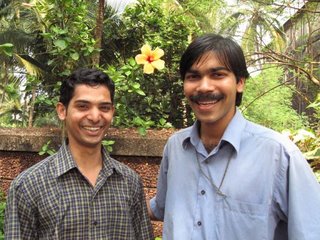 Savio and Ashwin (part of the package Nishant arranged),
Savio and Ashwin (part of the package Nishant arranged),
met a bunch more interesting people, including Yakub, a South African businessman
 who was buying maerial in Bombay, flew to Bombay, then got picked up by Surendra and driven to Pune (pronounced there 'puna') where we toured Philip Jose's (remember him, he was taking his grandfather back to Kerela after the housewarming) rubber factories
who was buying maerial in Bombay, flew to Bombay, then got picked up by Surendra and driven to Pune (pronounced there 'puna') where we toured Philip Jose's (remember him, he was taking his grandfather back to Kerela after the housewarming) rubber factories
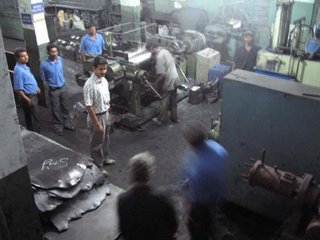 and new house and met his parents, wife, brother, and brother in law.
and new house and met his parents, wife, brother, and brother in law.
The next day we drove to Ajanta Caves and the next day to Ellora Caves.
I can't believe that everyone knows about an erector set tower in Paris, but hardly anyone knows about these two sets of caves.
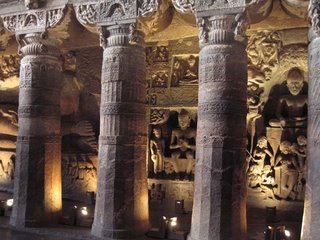 Though cave is hardly the right description.
Though cave is hardly the right description.
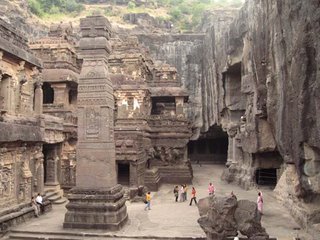
These are temples carved into solid rock over about 900 years altogether. More on this later. In fact, we leave India for the US tomorrow night and we've barely scratched the surface of India, and this blog has barely scratched the surface of our trip.
I'll try to put some of the better pics and interesting stories up in the next couple of weeks when we get home. A couple of pics in the mean time.
 Savio and Ashwin (part of the package Nishant arranged),
Savio and Ashwin (part of the package Nishant arranged), met a bunch more interesting people, including Yakub, a South African businessman
 who was buying maerial in Bombay, flew to Bombay, then got picked up by Surendra and driven to Pune (pronounced there 'puna') where we toured Philip Jose's (remember him, he was taking his grandfather back to Kerela after the housewarming) rubber factories
who was buying maerial in Bombay, flew to Bombay, then got picked up by Surendra and driven to Pune (pronounced there 'puna') where we toured Philip Jose's (remember him, he was taking his grandfather back to Kerela after the housewarming) rubber factories  and new house and met his parents, wife, brother, and brother in law.
and new house and met his parents, wife, brother, and brother in law. The next day we drove to Ajanta Caves and the next day to Ellora Caves.
I can't believe that everyone knows about an erector set tower in Paris, but hardly anyone knows about these two sets of caves.
 Though cave is hardly the right description.
Though cave is hardly the right description. 
These are temples carved into solid rock over about 900 years altogether. More on this later. In fact, we leave India for the US tomorrow night and we've barely scratched the surface of India, and this blog has barely scratched the surface of our trip.
I'll try to put some of the better pics and interesting stories up in the next couple of weeks when we get home. A couple of pics in the mean time.
Friday, November 24, 2006
Catchup pictures

Salesmen in a sandal/shoe shop in Jaipur clowning for the camera.

Raghu, the owner the of place we stayed in Pushkar. We talked about the problems of tourism on this holy lake town.
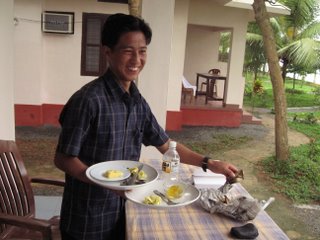

Thapa and Thomas worked at the Illikkalam Lake Resort in Kummarakom. I guess Thomas was shy. And this computer is uploading really slow. So, Thomas will remain hiding til later.

Our driver Pawan.
Bambolim Beach Resort
The 'resort' in Goa is quite nice. I'll try to get some pictures up. The colonial architecture and rich colors - yellows, brick reds, organges, whites - along with the lush tropical vegitation and beautiful blue pool are a nice relaxing respite. And we are on an almost deserted beach. The place hovers between elegant and shabby. Most of the guests are Indian. We met a young couple from Bangalore. Sareem is going to Chicago for three months late Dec. or early Jan. We also met an interesting Iranian couple. Both have spent considerable time in their lives outside of Iran. She's an architect and he's an academic who is currently a lecturer in Delhi. Ramin Jahanbegloo was released in September from four months in prison in Teheran. You can read more about it in the link. We had hours of interesting discussion. He's doing work on Gandhian non-violent ways of dealing with conflict as well as looking at the larger issue of cultural conflict and ways to reduce such conflict.
[Note: I posted pictures later at Bambolim Beach Resort.]
[Note: I posted pictures later at Bambolim Beach Resort.]
India Road Motto: Blow Horn
If we want to find some mottoes for India, Blow Horn would certainly be one. Not only is this motto plastered on the back of most trucks, every other vehicle driver practices it religiously. Basically it appears a way of saying, I'm behind you (or passing you) and I want you to move over or just know I'm here. There's no malice.

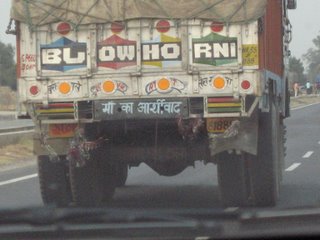

There is also the variation "Horn Please." In Kerrela we also saw, "Sound Horn."
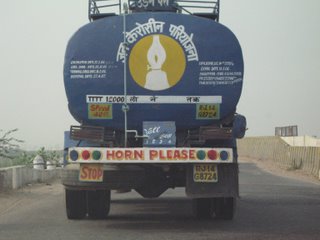
See follow-up post Awazdo.



There is also the variation "Horn Please." In Kerrela we also saw, "Sound Horn."

See follow-up post Awazdo.
Labels:
India
Wednesday, November 22, 2006
A Quickie from Goa
I'm in the 500 year old house of the travel guy Kenneth who picked us up atthe airport. It's huge, with very high ceilings. He's getting our credit card imprint. We met an Indian-American couple - Alex and Neetu - at the Kochi airport this morning. They are visiting relatives for two weeks, covering some of the same ground we have. Will post their pic soon. The airport guard told me pics were forbidden after I took it. They were on a connecting flight toi Delhi. We had 4 hours till our flight to Goa. So we walked to a Shiva temple someone in an airport shop told usabout. I don't know how to describe it. You walk past a numberof little exhibits about Shiva's life. 10 Rupees for flowers, 2 more to store your shoes, 20 more to go thru this grotto like space below the statue of Shiva (areally big statue). The grotto was a little like a Halloween haunted house - cave like.
Then 40 more Rupees to get coins to put into 109 cups while chanting a mantra.
I don't really know what it all means. It was connected to Kemp Fort Departmentstore where we were almostthe only customers and I bought a shirt. The guy there says the man who owns the store also owns the temple and the profits of the store go tothe temple.
Then 40 more Rupees to get coins to put into 109 cups while chanting a mantra.
I don't really know what it all means. It was connected to Kemp Fort Departmentstore where we were almostthe only customers and I bought a shirt. The guy there says the man who owns the store also owns the temple and the profits of the store go tothe temple.
Tuesday, November 21, 2006
Illikkalam Resort Kummarakom - Backwater
Here's an early morning view from our cottage. We were glad to see the rain had stopped and we were seeing blue sky for the first time since we got to India. Not that it has been cloudy, just the 'fog' and pollution hid the sky in the North.


We walked to the bird sanctuary thru the delightful village and canals.
 Part of the sanctuary tour included a ride in a pole boat.
Part of the sanctuary tour included a ride in a pole boat.



We walked to the bird sanctuary thru the delightful village and canals.
 Part of the sanctuary tour included a ride in a pole boat.
Part of the sanctuary tour included a ride in a pole boat.
Labels:
India
Camels

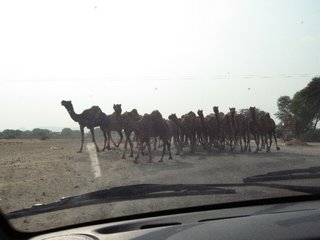


Taking pictures of camels and camel carts from a moving car is not easy. When Pawan finally stopped and let me out to take a picture - it was a great one - I guess I didn't push the button hard enough. Any way, here are some camel pictures between Bharatpur and Jaipur. As you can see, in Rajastan at least, camels are still an important means of transportation - even on the main highways.
Labels:
India
Taking Grandfather Home

We met Philip Jose on the plane from Mumbai to Kochi. He was taking his grandfather (88) back home after a celebration in Mumbai. Philip is headed to Ohio soon to meet with manufacturers of plastics. He works six months in India and six months in Dubai.
Jantar Mantar and Hawa Mahal

Jantar Mantar means - according to one of the guides leading one of the German or British tours - calculating tools. This is the observatory in the old town of Jaipur. It was begun in 1728 and has the world's largest sun dial as well as smaller ones. What was cool was that the shadows fall on arches on the sides of the 'needle'. The arches are marked off in to show hours and minutes, and the one I saw was exactly right to the minute. (you have to add 11 minutes)
There are also constructions to track the stars and planets. All very amazing.
Right near by is the Hawa Mahal (Hawa = wind, Mahal = palace). This one was built with lots of little holes so the women, who were not allowed out, could still view
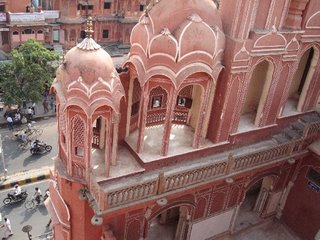 the street outside. These pictures give you just a tiny peek into the fantastical architecture of Jaipur. This computer is impossibly slow. Not even sure these pics will load.
the street outside. These pictures give you just a tiny peek into the fantastical architecture of Jaipur. This computer is impossibly slow. Not even sure these pics will load.
Labels:
India
Call Center Workers
We started talking to two young men yesterday as we were getting on the ferry from Fort Cochin back to Ernakulum (same emphasis as binoculars). They are studying English and are hoping to becom call center workers because the money is good. I asked how much. They said 20,000 Rupees a year. Now, I'm not sure I got this right because that is only about $500. Less than $2 per day, which is one of the measures of poverty. But Nishant had told us earlier that a family could live on 15,000 Rupees a year and our driver said he made 1500 per month.
Labels:
India
Stamp collector, House names

As we walked back from the bird sanctuary in Kummarakom, a young man asked - as does everyone else - "What country?" The short story is that he collects stamps and so here's his address. If you have old stamps from envelopes sent to you, send them to him. Geeno is the one in the middle in back in the blue shirt, with his aunt, uncle, cousin, mother, and grandmother.
Geeno P. Teny
Paruthiparampil
Kumarakom PO
Kottayam
Kerela
India
The Para... is a 'housename'. Someone else mentioned housenames to us. We also heard a little bit about housenames in China. If anyone knows more about house names, post a comment and enlighten us all.
Labels:
India
Where the hell are they?

I figured it was time to give you a sense of where all we are. We started in Delhi - upper left/middle of the map.
1 - trip to Amritsar and back (train)
2 - to Agra (Taj Majal) (by car)
3 - to Bharatpur (bird sanctuary)
4 - to Jaipur (I'll try to post pics, but this computer is slow)
5 - to Pushkar - the holy lake - then back to Jaipur and Delhi
6 - fly to Kochi (was Cochin) (with a stop in Mumbai (was Bombay) taxi two hours to Kummarakom for two nights, then back up to Kochi where we are now. About 4 hours flying time total.
7 - tomorrow we are scheduled to fly to Goa with a stop in Bangalore. We'll relax at the beach for 6 days there.
8 - fly to Mumbai, we immediately drive to Aurangabad on Nov 27 to see the Ellora and Ajanta caves nearby
Then back to Delhi on Nov 30 and leave for LA on Dec. 1 at 11:35pm if all goes well
Labels:
India
Saturday, November 18, 2006
Kumarakom, Kerala
No internet for two days. We are in southern India now - Kerela
State near Cochin, now Kochi - and it is a totally different world.
Here it is more like rural Thailand and much less crowded, much more
prosperous. And the sky is blue, though it wa raining when we arrived
yesterday. Went to the bird sanctuary this morning at 7 and went out
in a little boat, a man with a pole, and our guide pointed out
and named various birds. Very enjoyable and relaxing. Can't add any
more pictures now because I didn't bring the connector.
I do want to mention the other parts of the travel - getting from place to place. It took 6 hours to go the 325 km (about 200miles) from Jaipur to Delhi - about 2 hours spent on the last 50 km (30 miles) getting into Delhi.
Then yesterday we were up at 5:30am, picked up at 6 and to the airport, where our flight out was delayed an hour. Stopped in Mumbai (Bombay) and then to Kochi (Cochin). Philip Jose sat next to us on the second part of the flight, accompanying his grandfather home. He was a wonderful introduction to Kerela and gave us his cell number if we had any problems.
Nishant, as always, was fantastic. He had everything planned out. (He has the blog address now so I can ony say good things. :) ) If you read this Nishant, our phon isn't able to call out. It does seem you called.
It was raining, but we were picked up and driven to Kochin where the travel agent got out - he needed 800 more than the original price, to pay for the taxi from the Kochi hotel to the airport - and then we drove about 2.5 hours more into little back villages to Kumarakom, where our 'hotel' is a beautiful little cottage on the lake. This is where people boat back into the canals, and we have lovely little spot in a locally owned place that is not much more than someone's lot that added these first class bungalows. Dinner was made to order and brought to our porch where we ate looking over the dark lake. At less than $40 a night it is a bargain compared to the international hotels nearby that are $180 on up. Nishant, you did a great job.
State near Cochin, now Kochi - and it is a totally different world.
Here it is more like rural Thailand and much less crowded, much more
prosperous. And the sky is blue, though it wa raining when we arrived
yesterday. Went to the bird sanctuary this morning at 7 and went out
in a little boat, a man with a pole, and our guide pointed out
and named various birds. Very enjoyable and relaxing. Can't add any
more pictures now because I didn't bring the connector.
I do want to mention the other parts of the travel - getting from place to place. It took 6 hours to go the 325 km (about 200miles) from Jaipur to Delhi - about 2 hours spent on the last 50 km (30 miles) getting into Delhi.
Then yesterday we were up at 5:30am, picked up at 6 and to the airport, where our flight out was delayed an hour. Stopped in Mumbai (Bombay) and then to Kochi (Cochin). Philip Jose sat next to us on the second part of the flight, accompanying his grandfather home. He was a wonderful introduction to Kerela and gave us his cell number if we had any problems.
Nishant, as always, was fantastic. He had everything planned out. (He has the blog address now so I can ony say good things. :) ) If you read this Nishant, our phon isn't able to call out. It does seem you called.
It was raining, but we were picked up and driven to Kochin where the travel agent got out - he needed 800 more than the original price, to pay for the taxi from the Kochi hotel to the airport - and then we drove about 2.5 hours more into little back villages to Kumarakom, where our 'hotel' is a beautiful little cottage on the lake. This is where people boat back into the canals, and we have lovely little spot in a locally owned place that is not much more than someone's lot that added these first class bungalows. Dinner was made to order and brought to our porch where we ate looking over the dark lake. At less than $40 a night it is a bargain compared to the international hotels nearby that are $180 on up. Nishant, you did a great job.
Labels:
India
Subscribe to:
Posts (Atom)